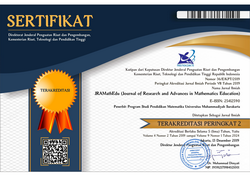The Imagery Models of Mathematics Teacher Candidates on Graph of Rational and Irrational Functions
Darmadi Darmadi(1*)(1) Faculty of Teacher Training and Education, Universitas PGRI Madiun
(*) Corresponding Author
Abstract
Keywords
Full Text:
PDFReferences
Arcavi, A. (2003). The role of visual representations in the learning of mathematics. Educational Studies in Mathematics, 52(3), 215-240.
Darmadi. (2011). Imagery students in learning real analysis (case study at IKIP PGRI Madiun). Paper presented at the National Seminar of UNY, Yogyakarta, December 3, 2011.
Darmadi. (2012). Build congenial learning mathematics with visualization. Paper presented at the National Seminar of UNY, Yogyakarta, March 24, 2012.
Darmadi. (2015). Visual thinking student profiles of prospective teachers of mathematics in understanding the formal definition based on Gender differences. Unpublished dissertation, UNESA, Surabaya, Indonesia.
Darmadi. (2016). Visual thinking student profiles of prospective teachers of mathematics in solving trigonometric problems. Journal of Math Educator, 2(2), 1-93. FKIP Universitas Nusantara PGRI Kediri.
Goldberg, R. R. (1964). Methods of real analysis. New York, London, Sydney & Toronto: John Wiley & Sons, Inc.
Goos, M., Stillman, G., & Vale, C. (2007). Teaching secondary school mathematics (Research and practice for the 21st century). Australia: Allen & Unwin.
Hershkowitz, R. (1990). Psychological aspects of learning geometry. In Nesher, P. & Kilpatrick, J. (Eds.), Mathematics and Cognition. A research synthesis by the International Group for the Psychology of Mathematics Education, ICMI Study Series, Cambridge University Press, pp. 70-95.
Tall, D. (2013). How humans learn to think mathematically. New York: Cambridge University Press.
Zimmermann, W. & Cunningham, S. (2011). Editors introduction: What is mathematical visualization. In W. Zimmermann & S. Cunningham (Eds.), Visualization in teaching and learning mathematics. Washington D.C.: Mathematical Association of America.
Article Metrics
Abstract view(s): 755 time(s)PDF: 601 time(s)
Refbacks
- There are currently no refbacks.







